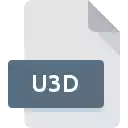.U3D File Extension

Universal 3D File
| Developer | 3D Industry Forum |
| Popularity | |
| Category | 3D Image Files |
| Format | .U3D |
| Cross Platform | Update Soon |
What is an U3D file?
The U3D file extension is associated with Universal 3D (U3D) file format, which is an open standard for representing 3D computer graphics data. U3D files are used to store and exchange 3D models and scenes, making them a crucial component of various applications, including 3D gaming, CAD (Computer-Aided Design), 3D printing, and virtual reality.
More Information.
The U3D file format was first introduced in 2005 as a successor to the older IDTF (Intel Data Format) file format. Its initial purpose was to provide a compact and efficient way to store 3D data, enabling faster loading and rendering of 3D content in various applications.
Over the years, U3D has gained popularity and has been widely adopted in the gaming, design, and visualization industries.
Origin Of This File.
The U3D file format originated from the need for a standardized way to represent 3D data across different software and platforms.
It was developed by the 3D Industry Forum (3DIF), a consortium of companies in the 3D graphics industry, with the goal of creating a universal 3D file format that could It can be used in a vast array of different applications.
File Structure Technical Specification.
U3D files consist of a hierarchical structure that includes information about 3D geometry, textures, materials, animations, and more. The format is based on the extensible XML (eXtensible Markup Language), making it human-readable and customizable. It supports both binary and ASCII encoding.
Technical Specifications:
- Geometry Data: Vertex positions, normals, and texture coordinates.
- Material Properties: Colors, textures, transparency, and shaders.
- Animation: Keyframes, bone animations, and skeletal hierarchies.
- Metadata: Author information, copyright, and version details.
How to Convert the File?
Converting U3D files to other 3D formats can be essential for compatibility and sharing purposes. Here’s how to convert U3D files on different platforms:
Windows:
- Autodesk Maya:
-
- Open Autodesk Maya.
- Go to “File” > “Import” to import the U3D file.
- Once imported, you can export the 3D model to various formats like FBX or OBJ by going to “File” > “Export Selection.”
- Blender:
-
- Launch Blender.
- Use the “File” > “Import” option to load the U3D file.
- After importing, go to “File” > “Export” to save the model in your desired format.
- Adobe Acrobat Reader:
-
- Open Adobe Acrobat Reader.
- Load the U3D file.
- While viewing the 3D model, you can save it as a U3D file, but exporting to other 3D formats may not be possible in this software.
Linux:
- Blender:
-
- Start Blender on your Linux system.
- Import the U3D file using “File” > “Import.”
- After importing, go to “File” > “Export” to save the 3D model in a different format like OBJ or FBX.
- FreeCAD:
-
- Launch FreeCAD.
- Import the U3D file.
- Once imported, you can export the model to other formats by going to “File” > “Export.”
- MeshLab:
-
- Open MeshLab.
- Import the U3D file.
- Go to “File” > “Export Mesh As” to save the 3D model in various formats supported by MeshLab.
Mac:
- Autodesk Maya (if available for Mac):
-
- Launch Autodesk Maya on your Mac.
- Import the U3D file using “File” > “Import.”
- After importing, you can export the model to different formats by going to “File” > “Export Selection.”
- Blender:
-
- Start Blender on your Mac.
- Import the U3D file using “File” > “Import.”
- After importing, go to “File” > “Export” to save the 3D model in a different format.
- Adobe Acrobat Reader:
-
- Open Adobe Acrobat Reader on your Mac.
- Load the U3D file.
- While viewing the 3D model, you can save it as a U3D file, but exporting to other 3D formats may not be possible in this software.
Android:
- 3D Viewer Apps:
-
- Go to Google Play Store. Google Play Store can be found on most Android devices.
- Find “3D viewer” apps such as “3D Model Viewer” or “3D Viewer for Android.”
- Install one of these apps and open it.
- Use the app’s file import feature to load and view U3D files.
iOS:
- 3D Viewer Apps:
-
- Go to the App Store on your iOS device.
- Search for “3D viewer” apps like “3D Model Viewer” or “3D Viewer for iOS.”
- Install one of these apps and open it.
- Use the app’s file import feature to load and view U3D files.
Advantages And Disadvantages.
Advantages:
- Portability: U3D files can be easily shared and opened on different platforms and applications.
- Compact Size: U3D files are relatively small in size compared to some other 3D formats, making them suitable for online distribution.
- Compatibility: Supported by a wide range of 3D modeling and rendering software.
- Customizability: The XML-based format allows for easy customization and integration into existing workflows.
Disadvantages:
- Limited Features: U3D may not support some advanced 3D features found in other formats.
- Compression Loss: High compression can lead to a loss of detail in complex 3D models.
- Not Widely Used: While popular in certain industries, U3D is not as widely adopted as formats like OBJ or FBX.
How to Open U3D?
Open In Windows
To open U3D files in Windows, you can use 3D modeling and rendering software like Autodesk Maya, Blender, or Adobe Acrobat Reader.
Open In Linux
Linux users can utilize 3D software such as Blender, FreeCAD, or MeshLab to open U3D files. Additionally, Adobe Acrobat Reader is available for Linux.
Open In MAC
Mac users can open U3D files using software like Autodesk Maya, Blender, or Adobe Acrobat Reader, which has Mac-compatible versions.
Open In Android
On Android devices, you can view U3D files using 3D viewer apps available on the Google Play Store. Adobe Acrobat Reader is also available for Android.
Open In IOS
iOS users can use 3D viewer apps from the App Store to open U3D files. Adobe Acrobat Reader is available for iOS as well.
Open in Others
U3D files can be opened on various other platforms using compatible 3D software or viewers. Ensure that the chosen software supports the U3D format for seamless access to 3D content.












